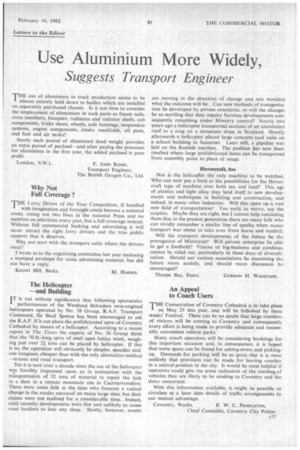Use Aluminium More Widely,
Page 57

If you've noticed an error in this article please click here to report it so we can fix it.
Suggests Transport Engineer
THE use of aluminium in truck production seems to be
almost entirely held down to bodies which are installed on separately purchased chassis. Is it not time to consider the employment of aluminium in such parts as frame rails, cross members, bumpers, radiators and radiator shells, cab components, brake shoes, wheels, axle housings, suspension systems, engine components, intake manifolds, oil pans, and fuel and air tanks?
Surely each pound of eliminated dead weight provides an extra pound of payload--and after paying the premium for aluminium in the first year, the added payload is pure profit.
London, S.W.I.
F. JOHN KEMP, Transport Engineer,
The British Oxygen Co., Ltd.
Why Not Full Coverage ?
THE Lorry Driver of the Year Competition, if handled
with imagination and foresight could become a national event, rating not two lines in the national Press and no mention on television every year, but a full coverage instead. Without full commercial backing and advertising it will never attract the right lorry drivers and the true public support that it deserves.
Why not start with the transport cafes where the drivers meet?
I wrote in to the organizing committee last year enclosing a stamped envelope for some advertising material, but did not have a reply.
Knowl Hill, Berks. M. HARRIS.
The Helicopter —and Building
TT is not without significance that following spectacular I performances of the Westland Belvedere twin-engined helicopters operated by No. 38 Group, R.A.F. Transport Command, Sir Basil Spence has been encouraged to ask the R.A.F. if it can place the prefabricated spire of Coventry Cathedral by means of a helicopter. According to a recent report in The Times the experts of No. 38 Group think that the 70-ft.-long spire of steel open lattice work, weighing just over 2+ tons can be placed by helicopter. If this is so, the operation will obviously be simpler, speedier and, one imagines, cheaper than with the only alternative method —cranes and road transport.
Yet it is now over a decade since the use of the helicopter was forcibly impressed upon us in connection with the transportation of 32 tons of material to repair the leak in a dam in a remote mountain site in Caernarvonshire. There were some folk at the time who forecast a radical change in the modus operandi on many large sites, but their claims were not realized for a considerable time. Indeed. until recently developments were few and unlikely to cause road hauliers to lose any sleep. Slowly, however, events are moving in the direction of change and one wonders what the outcome will be. Can new.methods of transportation be developed by private enterprise, or will the changes be so startling that they require Services developments 'consequently remaining under Ministry control? Nearly two years ago a helicopter transported sections of an aluminium roof to a crag on a mountain slope in Scotland. Shortly afterwards a helicopter placed large concrete roof units on a school building in Somerset. Later still, a pipeline was laid on the Kentish marshes. The position has now been reached where large prefabricated items can be transported from assembly point to place of usage.
Hovercraft, too Nor is the helicopter the only machine to be watched. Who can now put a limit to the possibilities for the Hovercraft type of machine over both sea and land? This age of plastics and light alloy may lend itself to new developments and techniques in building and construction, and indeed, in many other industries. Will this open up a vast new field of transportation? Too early to worry, say the -sceptics. Maybe they are right, but I cannot help reminding them that in the present generation there are many folk who can vividly remember a similar line of apathy when motor transport was about to take over from horse and tumbril.
Will the transport developments of the future be the. prerogative of Ministries? Will private enterprise be able to get a foothold? Visions of big-business and combines cannot be ruled out, particularly in these days of diversification. Should our various associations be examining the future more acutely, and should more discussion be encouraged?
Thorpe Bay, Essex. GORDON H. WAGSTAFF.
An Appeal to Coach Users
THE Consecration of Coventry Cathedral is to take place I on May 25 this year, and will be followed by three weeks* Festival. There can be no doubt that large numbers of visitors will be coming to Coventry and consequently every effort is being made to provide adequate and reasonably convenient vehicle parks.
Many coach operators will be considering bookings for this important occasion and, in consequence, it is hoped that some space can be found for setting-down and pickingup. Demands for Parking will be so great that it is most unlikely that provision can be made for leaving coaches• in a central position in the city. It would be most helpful if operators could give me some indication of the numbet of vehicles they are likely to be sending to Coventry and the dates concerned.
With this information available, it might be possible to circulate at a later date details of traffic arrangements to our mutual advantage.
Coventry, Warks. E. W. C. PENDLETON, Chief Constable, Coventry City Police.












































































































